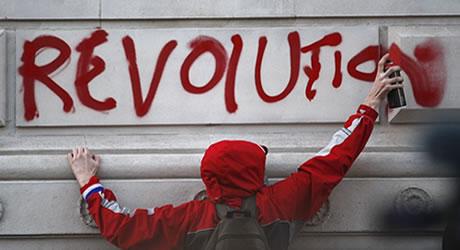On Tactics & The City

In London recently I witnessed an evolution in the tactics of demonstrations. For the first time in my life I saw a demonstration tactically out-manoeuvre the police. Anyone who has attended a demonstration in recent years will be familiar with the police tactic of 'kettling' – where the police, using lines of enormous, armed and armoured riot police, herd protestors into a contained area for hours, until eventually they allow individuals to leave, cold, hungry and exhausted, and finally round-up and arrest anyone hardy enough to stay put.
On the 30 November I joined a small march, comprised of students from my own university and a group from the University College London occupation, and together we marched to Trafalgar Square. Here we joined the main body of the demonstration. The plan was to make the short march down Whitehall to the Houses of Parliament. As we started to march we were met with hundreds of police who drove us back to Trafalgar Square. We then tried to get to Parliament Square through St. James' Park. Again we were stopped by lines of riot police.
Up to this point everything had been going as per usual and we were just settling into the normal back and forth of a demonstration. However, instead of returning to Trafalgar square the group splintered, some returned to Trafalgar Square, others, I heard later went towards Buckingham Palace where they were kettled, while the group I was in set off westwards at top speed (by forced march, as Julius Caesar would have said). In all we marched nearly ten miles, initially heading west but eventually looping around east where we marched down several of the main thoroughfares including Oxford St., Regents St. and the Holborn Viaduct, which is one of the major roads into and out of the financial district. It took me a while to realise what we were actually doing but eventually it dawned on me. We were obstructing the major transport routes in the city and, furthermore we were moving so quickly and anarchically (because nobody really knew where we were going) that the police could not deploy quickly enough to contain us.
On top of this we occasionally went down small side streets, which served the dual purpose of allowing the march to condense again (over such long distances, particularly at speed, the group was tended to get very spread out) and also to hide us from the police helicopter which was occasionally tracking our movements. Towards the end of the march I met two people who told me that they had been running ahead of the march spotting police lines and informing the people at the head of the march so that we could change direction and avoid being kettled. By the end of the ten miles the group had thinned out substantially. We had set off with well over five hundred people, but when we returned there were only about two hundred of us. The length of the march, the cold (it was snowing heavily all day) and the fact that many were frustrated by the apparent lack of plan, all took their toll. However, in spite of this, the tactic was extremely successful at causing delays throughout the city.
The tactic originated, I believe, at a meeting of the National Students Assembly prior to the march which agreed that 'Should the police interfere or refuse access to P[arliment] square, the consensus is that the city is to be 'shut down' (bridges, roads, etc)'. I would argue that this tactic, performed on a large scale, that is to say by several autonomous groups at once, each moving anarchically in order to avoid police and to disrupt the working of the city, could serve to successfully 'shut down' any city.
Many of the demonstrations I have attended in the last few years have been almost symbolic gatherings. At best they show the numbers of people who support a particular cause, at worst they serve to placate our conscience, allowing us to pretend that we have tried and failed. These tactics have failed again and again – Afghanistan, Iraq, G20, G8 etc. We have allowed demonstrations be reduced to this symbolic role by allowing ourselves be contained. This tactic has the potential to break this containment by providing an alternative to our blind submission to the police violence of kettling, and to make demonstrations truly affective. Our voices will be heard through the pounding of the traffic jams, the slamming of shops' shutters and howling of police sirens because we will transform those noises into our voice.
Finally I would like to express my solidarity and, I'm sure, the solidarity of all my fellow protestors in Britain, with our comrades in Ireland. Ours is a shared struggle.
